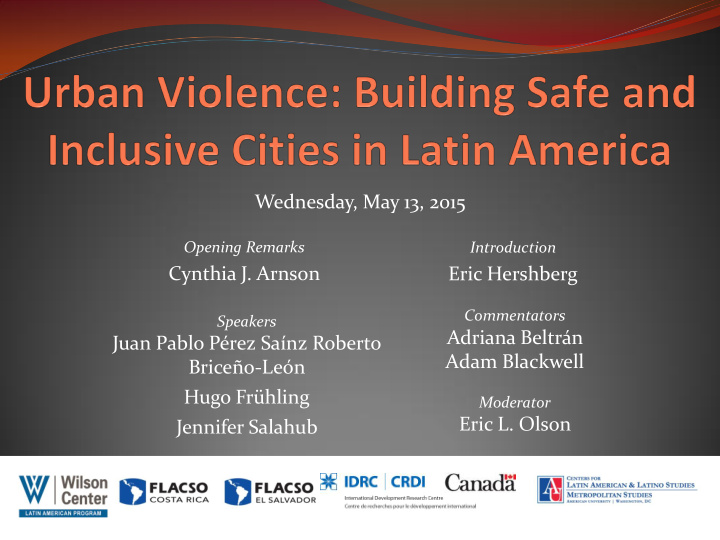



Wednesday, May 13, 2015 Opening Remarks Introduction Cynthia J. Arnson Eric Hershberg Commentators Speakers Adriana Beltrán Juan Pablo Pérez Saínz Roberto Adam Blackwell Briceño-León Hugo Frühling Moderator Eric L. Olson Jennifer Salahub
EXCLUSION, VIO IOLENCE AND COMMUNITY RESPONSES IN IN CENTRAL AMERICAN CIT ITIES: Guiding policy by explaining variation by FLACSO-Costa Rica and FLACSO-El Salvador
Description of f the project • Research question from SAIC: Why urban communities with similar conditions of social and economic exclusion, have different levels of violence? • Main hypothesis of our research: In urban marginal communities with similar conditions of social exclusion, different levels of violence can be explained because communities capacities to face violence. • Methodology: • Nine communities in urban areas (metropolitan and no metropolitan areas). • Three communities in Costa Rica and six in El Salvador. • Mix of quantitative and qualitative techniques of research.
Three basic ic thoughts for policy making o The existence of a community, as social actor, cannot be taken for granted. o The necessity to identify different types of violence and to balance their importance. o In the Salvadoran cases, the maras are an ambiguous phenomenon.
FIR IRST thought: The exis xistence of a communit ity, , as social l actor, cannot be taken for granted • Factors that hinder collective action and organization: • Territorial factors • Social factors • Factors associated to violence • Consequences for policy: • Interventions are unavoidable exogenous to the territories. • Interventions should also aim to constitute the community as an actor. • Factors that can foster or hinder the constitution of the community as an actor: leadership; types of organization; women participation; political clientelism and presence of institutions and especially of local governments.
SECOND THOUGHT: The necessit ity to id identify fy dif ifferent typ ypes of vio iole lence and to bala lance their ir im importance • Contextual violence • Micro markets of drugs in Costa Rica and maras in El Salvador. • The importance of exogenous factors: • Social exclusion (extreme disempowerment in labor markets and the territorial absence of the State). • The transformation of Central America as a new corridor for international drug flows. • Profit seeking violence and social violence • Profit seeking violence (assaults, theft, burglary, etc.) emerges as the most dangerous form of violence in the social imaginary. • Social violence (intra-domestic and among neighbors) happens in daily basis but it is silenced and tends to become natural and invisible. • The necessity for the re-equilibrium between these two types of violence.
THIR IRD THOUGHT: In In the Salv lvadoran cases, maras are an ambig iguous phenomenon • Nature of ambiguity: • The maras have the monopoly of violence in the communities: economic extortion, rape of young women, recruitment of children, etc. Do not forget the victims. • But, they offer protection against external violence and they intervene regulating social violence. • Policy choice in terms of citizen security: • Social reinsertion versus repression of maras . • Factors that may affect the policy choice: • Presence or absence of institutions that challenge the monopoly of violence by the maras . • (Un)sustainable economic projects for ex-members of the maras . • Hidden agenda by the leaders of the maras . • Moment of the prevalence of the logic of reinsertion or repression.
Recommend
More recommend